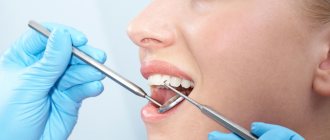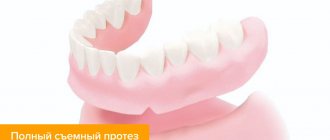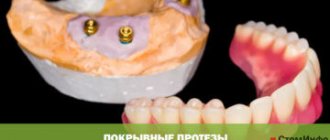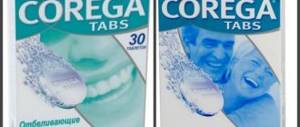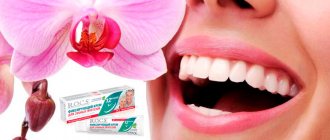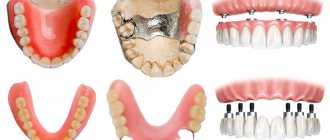Dental problems have plagued humanity since the beginning of time. In medieval Japan, for example, people were so desperate to give their smile an ideal look that the problem was solved radically: all Japanese, both men and women, painted their teeth with black varnish, which completely hid all imperfections, including the absence of some teeth.
A gap-toothed smile still causes serious psychological problems for its owner, but we live in a different culture, and the methods of the medieval Japanese do not suit us. Modern people cope with missing teeth using different types of dentures. Among them, acetal clasp dentures occupy far from the last place - they effectively cope with the restoration of chewing function and the natural aesthetic appearance of the dentition.
What kind of prosthesis is this and what features does it have?
An acetal denture is a partial removable [1] orthopedic structure made of synthetic resin (polyacetal). It is light and durable, allowing you to make comfortable dentures for installation on the upper or lower jaw with partial absence of teeth. Acetal is most often used to make crowns, hooks or clasps (fixing components), frames or arches, and less commonly - core inlays, gum formers for installation on implants. Removable acetal ones are attached to the supporting teeth using clasps.
PROSTHETICS WITH 6 OSSTEM IMPLANTS FROM RUB 200,000.
Complex implantation Osstem (South Korea) with delayed loading after 4-6 months.
Call now or request a call
Acetal removable dentures are distinguished from others by the shade of the clasps, frame (arch), and palatal bridge on the upper jaw. If, for example, clasp ones are gray metallic, and acrylic and nylon ones are translucent pink, then acetal ones are white or milky matte, not transparent.
How much does partial denture cost?
The average cost of clasp dentures in Moscow consists of the cost of the material, the work of the dental technician and the method of attachment to the supporting teeth. So, despite their popularity, the cost of nylon quadrotti dentures for one jaw is approximately the same as the price of clasp dentures - from 45,000 rubles and more. Clasp dentures with locks are somewhat more expensive - from 35,000 to 80,000 rubles. The most expensive of removable structures are considered to be dentures with telescopic crowns - their price ranges from 100,000 rubles to 200,000 rubles and more. As for clasp dentures on implants, their cost starts from 90,000 to 200,000 rubles and more, depending on the number of implants installed. If you decide to have a clasp prosthesis installed, then choose trusted clinics here.
High-quality clasp prosthetics is a worthy alternative to implantation, and in times of economic depression, clasp prosthetics is the most optimal option for restoring missing teeth.
What material is used
Acetal (more precisely, polyacetal, polyformaldehyde, polyoxymethylene) is an organic thermoplastic compound discovered about 100 years ago. The material is initially crystalline and has a white, or rather milky color, and is opaque. Some manufacturers color the material according to the Vita scale in 15-17 shades for artificial teeth and pink shades for gums. The material is supplied marked: “Acetal plastic” or “monomer-free acetate plastic”. Quality brands – Evihard, Nuxen, Pressing Dental Srl
Acetal is hydrophobic, i.e. does not absorb oral fluid, saliva, or water at all. It is resistant to alkalis, but can be destroyed in an acidic environment, so you should be careful when consuming acidic foods and drinks.
In terms of strength, polyacetal can be compared with a cobalt-chromium alloy - they have approximately equal characteristics in terms of distribution of chewing load, resistance to abrasion and deformation during long-term use. The material melts at a temperature of 180 degrees Celsius, i.e. You can safely consume hot food and drinks. The absence of toxic acrylic monomer in the composition greatly reduces the risk of an allergic reaction.
Indications and contraindications
Indications for the installation of acetal prostheses are the following cases:
- the need to restore 1-2 or more teeth: for good fixation and load distribution, at least 6-7 teeth must be preserved in the row,
- the remaining teeth exhibit mobility of the 1st degree,
- increased abrasion of enamel,
- included and end defects: in the first case, teeth are preserved along the edges of the “gap” (where there is no tooth), in the second case there are no teeth at the edge of the row,
- inflammation of the gums: gingivitis, periodontitis,
- inconvenience in wearing other orthopedic structures: for example, if acrylic ones cause discomfort due to their massiveness, and clasp ones provoke galvanosis (the appearance of an electrical impulse between dissimilar metals),
- allergies to other synthetic materials and metals,
- the need for temporary prosthetics before implantation, if it is not yet possible to install implants.
Contraindications are such clinical cases as:
- complete or almost complete edentia (absence of teeth),
- pronounced mobility of the remaining supporting teeth,
- severe atrophy of the alveolar ridge (loss of bone and gums),
- allergic reaction to the material or increased sensitivity of the gums,
- small sizes of supporting crowns: hook-clasps will not be able to attach well to them, they will fly off or overload this area.
Types of orthopedic structures
The classification identifies several options for acetal dentures. Depending on the location of installation, it can be on the lower or upper jaw. In length – an immediate prosthesis (“butterfly”) for 1-2 teeth and an extended orthopedic structure that restores multiple and/or scattered defects in a row. As a rule, the last option is most often used, because The material is too hard for a butterfly.
As for popular varieties, they can be as follows:
- prosthesis with acetal clasps,
- clasp acetal dentures for the upper and lower jaws.
Clasp prosthesis made of acetal (without metal)
Such a device can be called a complete analogue of the clasp one. Only in acetal, the arch or frame is made of white acetal - there is no metal at all in this orthopedic design. Pink gum is built up on top of the arch; it can also be made of acetal or more transparent and elastic acrylic. Hooks or clasps are also made of acetal. Artificial teeth can be made from the same material, or they can be made from more pliable plastics. For attachment to the upper jaw there is an acetal palatal bridge. According to patient reviews, acetal dentures are lighter than classic clasp dentures with hooks, and are fixed in the oral cavity just as reliably.
Clasp metal with acetal clasps
In a traditional clasp denture, there is a metal arch inside and metal clasps on top - they grip the supporting teeth like small processes or “claws”. But when you smile, gray clasps can be noticeable. Therefore, it is allowed to make hooks from acetal, but leave the arc metal.
Read more about all possible prosthetic options for partial absence of teeth on one or two jaws.
Oral care after dentures
Acetal dentures are quite easy to use - they do not need to be removed at night, you just need to carry out standard hygiene measures to maintain oral health. You can brush your teeth with such prosthetic structures in the usual way, but at least twice a day. Your doctor will tell you which toothpaste and brush to choose in order to preserve the beauty of your smile for a long time during the consultation after installing the product.
Dentures made from acetal should be immersed in a special disinfectant solution once a day. It is enough for the prosthesis to remain in this liquid for half an hour. In this way, the hygienic and aesthetic properties of the dental prosthetic structure can be preserved.
Modern science and medical technology are advancing at an impressive rate, and dental orthopedics takes advantage of many of these advances. If the question of dental prosthetics arises, there is no need to be afraid for the aesthetics and hygiene of the products that the doctor will offer. Acetal prosthetic products are one of the options for solving the problem of how to restore a beautiful smile, and with it, self-confidence.
Advantages and disadvantages
If we consider the pros and cons of acetal dentures, then they provide more benefits for patients - in comparison with conventional acrylic or even reliable clasp structures. The advantages of acetal products are as follows:
- good fixation on the teeth and uniform distribution of the chewing load (in comparison with acrylic ones): this is facilitated by fairly rigid acetal clasps and frame,
- ease of design and its installation in the oral cavity,
- good aesthetics: white clasps are not as noticeable on the teeth as gray metal ones,
- quick adaptation: the acetal removable denture on the upper jaw has only a thin bridge, and on the lower jaw there is a small imitation of gum, so it does not overlap the taste buds so much, distorts diction less, and does not provoke nausea,
- relatively simple care: there is no need to remove the denture every time after eating,
- acetal clasps put less pressure on crowns, so the enamel does not wear off as much as with metal hooks,
- flexibility and lower risk of breakage: the acetal frame can be bent 90 degrees, and it will not break or bend - it will return to its original position. Patients note that if they fall from a height (with careless handling), the prosthesis may not crack/break,
- you can get dentures for periodontal diseases, for loose teeth (but not in severe cases),
- low risk of allergies,
- low cost.
Disadvantages include factors such as:
- rigidity of the orthopedic structure: can provoke increased atrophy of bone tissue, loosening of teeth due to periodontitis (if the patient places or removes it incorrectly),
- as atrophy progresses, chafing on the gums, pain, stomatitis,
- when worn for a long time, you have to glue the prosthetic base onto a fixing cream (“Koregu” or “Protefix”),
- chewing with removable dentures is not very comfortable: only 6 out of 10 people say that they are relatively comfortable using removable devices,
- opacity of the material: therefore, the aesthetics here are lower than, for example, nylon,
- over time, the material absorbs dyes from food, becomes colored by tobacco smoke, darkens from plaque,
- there is a risk of breakage of individual clasps.
Nylon clasp quadrotti prosthesis
A product of the Italian company Quattro Ti, the quadrotti clasp prosthesis is very similar to a removable nylon prosthesis, with the only difference being that during its manufacture, nylon is mixed with hypoallergenic plastic. The resulting material has a number of advantages: it is more durable than nylon, and artificial teeth do not show through it. According to the manufacturers, this type of metal-free clasp prosthesis does not deform over time, does not cause discomfort when worn, and looks much more aesthetically pleasing than other prostheses. A soft prosthesis is attached to the teeth using plastic clasps, or saddles, covered on top with the same material as the base of the prosthesis. Saddles can be either pink or white, making them unnoticeable on the teeth. As for the disadvantages of the prosthesis, firstly, Quattro Ti is not strong enough, since no matter how strong the plastic is, it cannot be compared with metal. Secondly, a clasp prosthesis with nylon saddles requires special care using special means, which requires additional costs and cannot be repaired.
How is production and installation carried out?
First, the patient undergoes diagnostics (examination, x-rays), sanitation of the oral cavity (removal of diseased and damaged teeth). After that, impressions are taken from the dentition, and an individual impression tray is made. Next, impressions are made again, a working model is made, and the future orthopedic product is cast and pressed on it.
The manufacturing technology of an acetal prosthesis is quite complex, and such a design is created only in a dental laboratory with modern equipment. Since acetal granules begin to melt at a temperature of 180 degrees Celsius, a thermal injection press will be required to make the prosthesis.
Then the finished structure or arch with clasps is cooled and tried on a model or directly to the patient. Next, gums are added to the frame, crowns are placed, the product is polished and sent for final fitting. If there are no shortcomings, it is installed for the patient.
Stages of making a clasp prosthesis
Based on the principle of making the frame, the clasp prosthesis is divided into several types: soldered, solid-cast, milled, and based on laser sintering of nanoparticles of a special metal alloy powder. The last two methods are considered the most progressive and allow you to create a high-precision (up to 10 microns) and comfortable design.
Manufacturing takes place in 4 stages:
- first the dental technician creates a plaster model
- Based on the plaster model, a prototype of the prosthesis is cast and scanned
- using the scan, the frame of the clasp structure is modeled on a computer
- the prosthesis is ultimately sintered or milled.
The result exceeds all expectations - the prosthesis fits tightly to the gums and teeth, does not break and looks very aesthetically pleasing.
Service life and care
The service life of a removable acetal prosthesis is 3-5 years. With good care it can be extended a little. To do this, you need to regularly remove the structure from your mouth for cleaning and disinfection (once every 1-2 weeks), because without proper cleaning, the surface will quickly darken. In addition, you need to brush your teeth twice a day - your own and artificial ones, using a special brush and toothpaste. To prevent breakage and displacement during the act of chewing, you should avoid hard and stretchy foods. Do not chew candy or nut shells, avoid toffees and toffees, and do not open jars with your teeth. You should also regularly visit an orthopedic dentist for examination and correction of the prosthesis, minor repairs and cleaning if necessary.
Alternatives to acetal prosthesis
An alternative among removable ones can be any partial removable one - acrylic, nylon, Acry-free. But the clasp and Quattro Ti (“Quadrotti”) are considered the closest, since they, along with acetal, have compact sizes and a thin palatal bridge for fixation on the upper jaw.
But these are all removable options that do not stop, and sometimes even worsen, the atrophy of the jaw bone tissue - experts recommend them only for temporary wearing. Therefore, the best way to permanently restore lost teeth is implantation. Here the orthopedic structures are attached most reliably, there is no need to remove them, and they are very easy to care for. Plus, bone atrophy stops, because the implant, as an analogue of the root, correctly transfers the load to the bone tissue.
“A former classmate once recommended a good dentist, who installed implants for my crowns. About prosthetics they said that only in six months. But without teeth you can’t walk, you can’t smile, you can’t talk. So the doctor chose a good acetal prosthesis for me. For a while. As long as I wear it normally, I haven’t noticed any problems. But, of course, I already want to get the crowns installed as soon as possible. There is no need to remove them to clean them.”
Sergey_76, review from irecommend.ru
Peculiarities
Dental restoration with acetal structures is a fairly young technique that has just begun to gain popularity. But now such products are enjoying success due to the high quality of the material.
Prostheses made from acetal have some features that distinguish them from other materials:
- Acetal is biologically compatible with all materials.
- Its strength is the same as that of metal, but its flexibility is tens of times better.
- The structure, made of acetal, can be fixed to the dentition using both acetal and metal clasps , invisible to others.
- Prostheses made from this material are installed both for the restoration of single teeth and in the absence of more of them.
Breakage of the acetal sheet is possible only when it is bent up to 90°.

